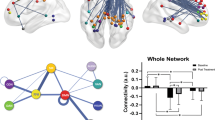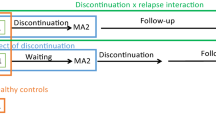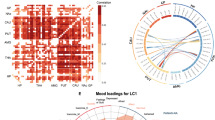Abstract
Recurrent episodes in major depressive disorder (MDD) are common but the neuroimaging features predictive of recurrence are not established. Participants in the Predictors of Remission in Depression to Individual and Combined Treatments (PReDICT) study who achieved remission after 12 weeks of treatment withcognitive behavior therapy, duloxetine, or escitalopram were prospectively monitored for up to 21 months for recurrence. Neuroimaging markers predictive of recurrence were identified from week 12 functional magnetic resonance imaging scans by analyzing whole-brain resting state functional connectivity (RSFC) using seeds for four brain networks that are altered in MDD. Neuroimaging correlates of established clinical predictors of recurrence, including the magnitude of depressive (Hamilton Depression Rating Scale), anxiety (Hamilton Anxiety Rating Scale) symptom severity at time of remission, and a comorbid anxiety disorder were examined for their similarity to the neuroimaging predictors of recurrence. Of the 344 patients randomized in PReDICT, 61 achieved remission and had usable scans for analysis, 9 of whom experienced recurrence during follow-up. Recurrence was predicted by: 1) increased RSFC between subcallosal cingulate cortex (SCC) and right anterior insula, 2) decreased RSFC between SCC and bilateral primary visual cortex, and 3) decreased RSFC between insula and bilateral caudate. Week 12 depression and anxiety scores were negatively correlated with RSFC strength between executive control and default mode networks, but they were not correlated with the three RSFC patterns predicting recurrence. We conclude that altered RSFC in SCC and anterior insula networks are prospective risk factors associated with MDD recurrence, reflecting additional sources of risk beyond clinical measures.
This is a preview of subscription content, access via your institution
Access options
Subscribe to this journal
Receive 13 print issues and online access
$259.00 per year
only $19.92 per issue
Buy this article
- Purchase on Springer Link
- Instant access to full article PDF
Prices may be subject to local taxes which are calculated during checkout


Similar content being viewed by others
References
Keller MB, Boland RJ. Implications of failing to achieve successful long-term maintenance treatment of recurrent unipolar major depression. Biol Psychiatry. 1998;44:348–60.
Greden J. The burden of recurrent depression: causes, consequences, and future prospects. J Clin Psychiatr. 2001;62:5–9.
Bockting CL, Hollon SD, Jarrett RB, Kuyken W, Dobson K. A lifetime approach to major depressive disorder: the contributions of psychological interventions in preventing relapse and recurrence. Clin Psychol Rev. 2015;41:16–26.
Guidi J, Tomba E, Fava GA. The sequential integration of pharmacotherapy and psychotherapy in the treatment of major depressive disorder: a meta-analysis of the sequential model and a critical review of the literature. Am J Psychiatry. 2016;173:128–37.
Mattison C, Bogren M, Horstmann V, Munk-Jorgensen P, Nettelbrandt P. The long-term course of depressive disorders in the Lundby Study. Psychol Med. 2007;37:883–91.
Eaton WW, Shao H, Nestadt G, Lee HB, Bienvenu OJ, Zandi P. Population-based study of first onset and chronicity in major depressive disorder. Arch Gen Psychiatry. 2008;65:513–20.
Hardeveld F, Spijker J, De Graaf R, Nolen WA, Beekman AT. Recurrence of major depressive disorder and its predictors in the general population: results from the Netherlands Mental Health Survey and Incidence Study (NEMESIS). Psychol Med. 2013;43:39–48.
Borges S, Chen YF, Laughren TP, Temple R, Patel HD, David PA, et al. Review of maintenance trials for major depressive disorder: a 25-year perspective from the US Food and Drug Administration. J Clin Psychiatry. 2014;75:205–14.
Keller M, Trivedi MH, Thase ME, Shelton RC, Kornstein SG, Nemeroff CB, et al. The Prevention of Recurrent Episodes of Depression with Venlafaxine for Two Years (PREVENT) study: outcomes from the two-year and combined maintenance phases. J Clin Psychiatry. 2007;68:1246–56.
Kornstein SG, Kocsis JH, Ahmed S, Thase M, Friedman ES, Dunlop BW, et al. Assessing the efficacy of 2 years of maintenance treatment with venlafaxine extended release 75-225 mg/day in patients with recurrent major depression: a secondary analysis of data from the PREVENT study. Int Clin Psychopharmacol. 2008;23:357–63.
Shea MT, Elkin I, Imber SD, Sotsky SM, Watkins JT, Collins JF, et al. Course of depressive symptoms over follow-up. Findings from the National Institute of Mental Health Treatment of Depression Collaborative Research Program. Arch Gen Psychiatry. 1992;49:782–7.
Rush AJ, Kraemer HC, Sackeim HA, Fava M, Trivedi MH, Frank E, et al. Report by the ACNP Task Force on response and remission in major depressive disorder. Neuropsychopharmacology 2006;31:1841–53.
Mueller TI, Leon AC, Keller MB, Solomon DA, Endicott J, Coryell W, et al. Recurrence after recovery from major depressive disorder during 15 years of observational follow-up. Am J Psychiatry. 1999;156:1000–6.
Kennedy N, Abbott R, Paykel ES. Remission and recurrence of depression in the maintenance era: long-term outcome in a Cambridge cohort. Psychol Med. 2003;33:827–38.
Kanai T, Takeuchi H, Furukawa TA, Yoshimura R, Imaizumi T, Kitamura T, et al. Time to recurrence after recovery from major depressive episodes and its predictors. Psychol Med. 2003;33:839–45.
Buckman JEJ, Underwood A, Clarke K, Saunders R, Hollon SD, Fearon P, et al. Pilling S. Risk factors for relapse and recurrence of depression in adults and how they operate: A four-phase systematic review and meta-synthesis. Clin Psychol Rev. 2018;64:13–38.
Kennis M, Gerritsen L, van Dalen M, Williams A, Cuijpers P, Bockting C. Prospective biomarkers of major depressive disorder: a systematic review and meta-analysis. Mol Psychiatry. 2020;25:321–38.
Mocking RJT, Naviaux JC, Li K, Wang L, Monk JM, Bright AT, et al. Metabolic features of recurrent major depressive disorder in remission, and the risk of future recurrence. Transl Psychiatry. 2021;11:37.
Farb NA, Anderson AK, Bloch RT, Segal ZV. Mood-linked responses in medial prefrontal cortex predict relapse in patients with recurrent unipolar depression. Biol Psychiatry. 2011;70:366–72.
Lythe KE, Moll J, Gethin JA, Workman CI, Green S, Lambon Ralph MA, et al. Self-blame-selective hyperconnectivity between anterior temporal and subgenual cortices and prediction of recurrent depressive episodes. JAMA Psychiatry. 2015;72:1119–26.
Workman CI, Lythe KE, McKie S, Moll J, Gethin JA, Deakin JF, et al. A novel resting-state functional magnetic resonance imaging signature of resilience to recurrent depression. Psychol Med. 2017;47:597–607.
Langenecker SA, Jenkins LM, Stange JP, Chang YS, DelDonno SR, Bessette KL, et al. Cognitive control neuroimaging measures differentiate between those with and without future recurrence of depression. Neuroimage Clin. 2018;20:1001–9.
Kaiser RH, Andrews-Hanna JR, Wager TD, et al. Large-scale network dysfunction in major depressive disorder: A meta-analysis of resting-state functional connectivity. JAMA Psychiatry. 2015;72:603–11.
Dunlop BW, Binder EB, Cubells JF, Goodman MG, Kelley ME, Kinkead B, et al. Predictors of remission in depression to individual and combined treatments (PReDICT): study protocol for a randomized controlled trial. Trials 2012;13:106.
Dunlop BW, Kelley ME, Aponte-Rivera V, Kelley ME, McGrath CL, Choi KS, et al. Effects of patient preferences on outcomes in the Predictors of Remission in Depression to Individual and Combined Treatments (PReDICT) study. Am J Psychiatry. 2017;174:546–56.
Dunlop BW, Cha J, Choi KS, Rajendra JK, Nemeroff CB, Craighead WE, et al. Shared and unique changes in brain connectivity among depressed patients remitting with pharmacotherapy versus psychotherapy. Am J Psychiatry. 2023;180:218–29.
Kennedy JC, Dunlop BW, Craighead LW, Nemeroff CB, Mayberg HS, Craighead WE. Follow-up of monotherapy remitters in the PReDICT study: Maintenance treatment outcomes and clinical predictors of recurrence. J Consult Clin Psychol. 2018;86:189–99.
Aponte Rivera V, Dunlop BW, Ramirez C, Kelley ME, Schneider R, Blastos B, et al. Enhancing Hispanic participation in mental health clinical research: Development of a Spanish-speaking depression research site. Depress Anxiety. 2014;31:258–67.
First MB, Williams JB, Spitzer RL, Gibbon M. Structured clinical interview for DSM-IV-TR axis I disorders, clinical trials version (SCID-CT). New York: Biometrics Research, New York State Psychiatric Institute; 2007.
Hamilton M. A rating scale for depression. J Neurol Neurosurg Psychiatry. 1960;23:56–62.
Keller MB, Lavori PW, Friedman B, Nielsen E, Endicott J, McDonald-Scott P, et al. The Longitudinal Interval Follow-up Evaluation. A comprehensive method for assessing outcome in prospective longitudinal studies. Arch Gen Psychiatry. 1987;44:540–8.
Hamilton M. The assessment of anxiety states by rating. Br J Med Psychol. 1959;32:50–55.
Heberlein KA, Hu X. Simultaneous acquisition of gradient-echo and asymmetric spin-echo for single-shot z-shim: Z-SAGA. Magn Reson Med. 2004;51:212–6.
Cox RW. AFNI: software for analysis and visualization of functional magnetic resonance neuroimages. Comput Biomed Res. 1996;29:162–73.
Jo HJ, Gotts SJ, Reynolds RC, Bandettini PA, Martin A, Cox RW, et al. Effective preprocessing procedures virtually eliminate distance-dependent motion artifacts in resting state FMRI. J Appl Math. 2013; 2013: https://doi.org/10.1155/2013/935154.
Cox RW, Jesmanowicz A. Real-time 3D image registration for functional MRI. Magn Reson Med. 1999;42:1014–8.
Power JD, Barnes KA, Snyder AZ, Schlaggar BL, Petersen SE. Spurious but systematic correlations in functional connectivity MRI networks arise from subject motion. Neuroimage 2012;59:2142–54.
Jo HJ, Saad ZS, Simmons WK, Milbury LA, Cox RW. Mapping sources of correlation in resting state FMRI, with artifact detection and removal. Neuroimage 2010;52:571–82.
Sridharan D, Levitin DJ, Menon V. A critical role for the right fronto-insular cortex in switching between central-executive and default-mode networks. Proc Natl Acad Sci USA. 2008;105:12569–74.
Sheline YI, Price JL, Yan Z, Mintun MA. Resting-state functional MRI in depression unmasks increased connectivity between networks via the dorsal nexus. Proc Natl Acad Sci USA. 2010;107:11020–25.
Menon V. Salience network. In: Toga AW, editor. Brain Mapping: An Encyclopedic Reference. Vol. 2. London: Academic Press, Elsevier; 2015. p. 597–11.
Cox RW, Chen G, Glen DR, Reynolds RC, Taylor PA. FMRI Clustering in AFNI: False-positive rates redux. Brain Connect. 2017;7:152–71.
Yeo BT, Krienen FM, Sepulcre J, et al. The organization of the human cerebral cortex estimated by intrinsic functional connectivity. J Neurophysiol. 2011;106:1125–65.
Jarrett RB, Minhajuddin A, Gershenfeld H, Friedman ES, Thase ME. Preventing depressive relapse and recurrence in higher-risk cognitive therapy responders: A randomized trial of continuation phase cognitive therapy, fluoxetine, or matched pill placebo. JAMA Psychiatry. 2013;70:1152–60.
Blank TS, Meyer BM, Rabl U, Schögl P, Wieser MK, Pezawas L. Neurobiological predictors for clinical trajectories in fully remitted depressed patients. Depress Anxiety. 2021;38:447–55.
Treadway MT, Pizzagalli DA. Imaging the pathophysiology of major depressive disorder - from localist models to circuit-based analysis. Biol Mood Anxiety Disord. 2014;4:5.
Hamilton JP, Sacchet MD, Gotlib IH. Meta-analysis of functional neuroimaging of major depressive disorder in youth. JAMA Psychiatry. 2015;72:1045–53.
Li G, Liu Y, Zheng Y, Wu Y, Li D, Liang X, et al. Multiscale neural modeling of resting-state fMRI reveals executive-limbic malfunction as a core mechanism in major depressive disorder. Neuroimage Clin. 2021;31:102758.
Segal ZV, Kennedy S, Gemar M, Hood K, Pedersen R, Buis T. Cognitive reactivity to sad mood provocation and the prediction of depressive relapse. Arch Gen Psychiatry. 2006;63:749–55.
Bockting CLH, Smid NH, Koeter MWJ, Spinhoven P, Beck AT, Schene AH. Enduring effects of preventive cognitive therapy in adults remitted from recurrent depression: a 10 year follow-up of a randomized controlled trial. J Affect Disord. 2015;185:188–94.
Bockting CLH, Klein NS, Elgersma HJ, van Rijsbergen GD, Slofstra C, Ormel J, et al. Effectiveness of preventive cognitive therapy while tapering antidepressants versus maintenance antidepressant treatment versus their combination in prevention of depressive relapse or recurrence (DRD study): a three-group, multicentre, randomised control. Lancet Psychiatry. 2018;5:401–10.
Biesheuvel-Leliefeld KEM, Kok GD, Bockting CLH, Cuijpers P, Hollon SD, Van Marwijk HWJ, et al. Effectiveness of psychological interventions in preventing recurrence of depressive disorder: meta-analysis and metaregression. J Affect Disord. 2015;174:400–10.
Janiri D, Moser DA, Doucet GE, Luber MJ, Rasgon A, Lee WH, et al. Shared neural phenotypes for mood and anxiety disorders: A meta-analysis of 226 task-related functional imaging studies. JAMA Psychiatry. 2020;77:172–9.
Birn RM, Molloy EK, Patriat R, Parker T, Meier TB, Kirk GR, et al. The effect of scan length on the reliability of resting-state fMRI connectivity estimates. Neuroimage 2013;83:550–8.
Brydges C, Fiehn O, Mayberg HS, Schreiber H, MahmoudianDehkodori S, Bhattacharyya S, et al. Indoxyl sulfate, a gut microbiome-derived uremic toxin, is associated with psychic anxiety and its fMRI-based neurologic signature. Sci Rep. 2021;11:21011.
Funding
Supported by NIH grants P50 MH077083, RO1 MH080880, UL1 RR025008, M01 RR0039, K23 MH086690 and funding from the Fuqua family foundations. Forest Laboratories and Elli Lilly donated the study medications (escitalopram and duloxetine, respectively).
Author information
Authors and Affiliations
Contributions
BWD drafted the manuscript. BWD, CBN, WEC, and HSM designed the study. BWD, WEC, and HSM collected the study data. JC and KC analyzed the imaging data and prepared the figures. All authors edited the manuscript and approved the final version.
Corresponding author
Ethics declarations
Competing interests
Dr. Dunlop has received research support from Boehringer Ingelheim, Compass Pathways, NIMH, Otsuka, Sage, Usona Institute, and Takeda and has served as a consultant for Biohaven, Cerebral Therapeutics, Greenwich Biosciences, Myriad Neuroscience, NRx Pharmaceuticals, Otsuka, Sage, and Sophren Therapeutics. Dr. Cha reports no financial relationships with commercial interests. Dr. Choi has served as a consultant for Abbott Laboratories. Dr. Nemeroff has served as a consultant for AbbVie, ANeuroTech (division of Anima BV), Signant Health, Magstim, Inc., Intra-Cellular Therapies, Inc., EMA Wellness, Sage, Silo Pharma, Engrail Therapeutics, Pasithea Therapeutic Corp., GoodCap Pharmaceuticals, Inc., Senseye, Clexio, Ninnion Therapeutics, EmbarkNeuro, SynapseBio, BioXcel Therapeutics, and Relmada Therapeutics; he has served on scientific advisory boards ANeuroTech (division of Anima BV), Brain and Behavior Research Foundation (BBRF), Anxiety and Depression Association of America (ADAA), Skyland Trail, Signant Health, Laureate Institute for Brain Research (LIBR), Inc., Heading Health, Pasithea Therapeutic Corp., and Sage; he holds stock in Seattle Genetics, Antares, Inc., Corcept Therapeutics Pharmaceuticals Company, EMA Wellness, Naki Health, Relmada Therapeutics; he serves on the Board of Directors for Gratitude America, ADAA, and Lucy Scientific Discovery, Inc.; and he is named on U.S. patents 6,375,990B1 and 7,148,027B2. Dr. Craighead serves on the National Advisory Board for the George West Mental Health Foundation, as a board member of Hugarheill ehf (an Icelandic company dedicated to the prevention of depression), and as a scientific advisory board member for AIM for Mental Health and the Anxiety and Depression Association of America; he is supported by the Mary and John Brock Foundation, the Pitts Foundation, and the Fuqua family foundations; and he receives book royalties from John Wiley. Dr. Mayberg has received consulting and intellectual property licensing fees from Abbott Neuromodulation.
Additional information
Publisher’s note Springer Nature remains neutral with regard to jurisdictional claims in published maps and institutional affiliations.
Supplementary information
Rights and permissions
Springer Nature or its licensor (e.g. a society or other partner) holds exclusive rights to this article under a publishing agreement with the author(s) or other rightsholder(s); author self-archiving of the accepted manuscript version of this article is solely governed by the terms of such publishing agreement and applicable law.
About this article
Cite this article
Dunlop, B.W., Cha, J., Choi, K.S. et al. Functional connectivity of salience and affective networks among remitted depressed patients predicts episode recurrence. Neuropsychopharmacol. 48, 1901–1909 (2023). https://doi.org/10.1038/s41386-023-01653-w
Received:
Revised:
Accepted:
Published:
Issue Date:
DOI: https://doi.org/10.1038/s41386-023-01653-w



